︎︎︎ MELA PANAIA

The first mother plant was recovered in the area of Pieve Santo Stefano (Arezzo). This variety seems to have Tuscan origins and indeed it is cultivated in that region but very similar plants have also been found in other places in Umbria: Pietralunga (Perugia), Gualdo Tadino (Perugia), where it is called Pagliaccia (clown), and all the way down to southern Umbria near Norcia and Preci (Terni), where it is quite widespread. A few specimens have also been recovered in Abruzzo. It is suitable for high altitude cultivation and it is indeed cultivated in the high hills in both Tuscany and Umbria. The tree is moderately vigorous, with spreading crown; it crops every other year and blooms late in the season. It is very rugged. The fruit is large, somewhat round and very flattened. The stem is medium and inserted in a large, deep and very open cavity; the calyx is medium, semi-open and deep. The skin is shiny, with yellow-green background and widespread bright red over-layering. The flesh is white, slightly sour, aromatic, somewhat crisp and of good quality. The fruit is traditionally harvested in October and stores very well in the fruit-house until the following spring. It can also be eaten soon after harvest time. Its name may be connected to the large size of the fruit and to its similarity to the shape of bread (pane). In the Norcia and Preci area the “panaia” was also the name for the breadbasket. This variety is suitable for fresh eating and for baking in the oven with a little sugar sprinkled in the stem’s cavity and a little wine poured in the baking dish.